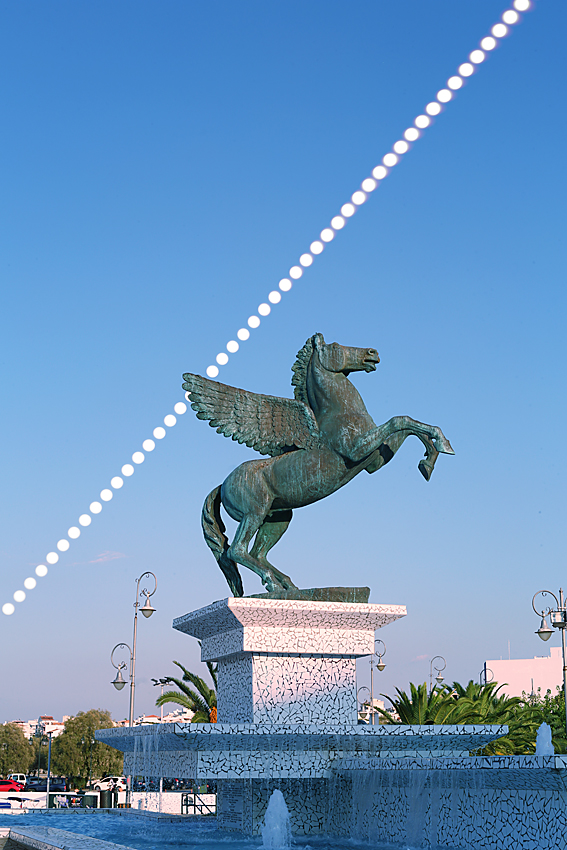
Our sun and closest star is believed to be approximately 4600 million years old and is composed (by mass) of hydrogen (74.5%), helium (23.5%)
and various other heavier elements (2%) such as oxygen and carbon. Due to this gaseous state, the sun does not rotate about its axis at one
uniform rate but has the poles rotating at a slower rate than the equatorial region. It has a central temperature of 14 million degrees
whereas the surface temperature is a mere 5500 °C. With a diameter of 1.4 million km, it is about 109 times as wide as Earth whereas with a
mass of 2 x 1030 kg, it is 335,000 times more massive than Earth. Of interest is the observation that its density of 1400
kg/m3 is only slightly more dense than water (1000 kg/m3).
Although the rising sun may seem to occur at approximately the same azimuth when observed from day to day, a longer term observational
project
will reveal this to be far from the truth. In fact, if we were to mentally note the azimuth of the rising sun around summer solstice in June
and repeat this exercise around winter solstice in December, we will note that the sun has shifted by approximately 65° during the intervening
six months!
This "moving target" involving the rising (or setting) sun is due to the elliptical nature of our planet's orbit around the sun which is
responsible for the variable arrival of the sun on the local meridian by up to 16 minutes early or late and the "Equation of Time" which is
described and documented elsewhere on this site along with the variable altitude due to
earth's tilt in its axis of rotation (23.45°) relative to its orbital plane.
Note: The image below is an extension of a prolonged effort to capture the Sun and Moon against notable
foregrounds. The primary task in such an exercise is to very precisely reverse engineer the perspective of the foreground of interest with
respect to its physical azimuth and altitude from my shooting location so as to have a suitable time series involving Sol in the background and
as indicated by the image below.
One of the most iconic and beloved figures from Greek mythology is the white-winged horse Pegasus. Sired by Poseidon and foaled by the gorgon
Medusa, Pegasus could not be born thanks to a curse by the goddess Athena against Medusa. Only after the slaying of Medusa by the hero Perseus
would Pegasus finally be born along with his brother Chrysaor from the flowing blood and wounds resulting from Medusa's beheading. Following
various escapades involving the heroes Bellerophone (battle against the Chimera) and Perseus (rescue of Andromeda) as well as the Muses, Zeus
would finally immortalize Pegasus amongst the stars and, hence, for the large constellation of Pegasus which dominates the sky during late
summer in both hemispheres. In fact, the constellations of Pegasus and Andromeda are interconnected thanks to the bond developed by Perseus
and Andromeda following her rescue with the help of Pegasus.
The beautiful bronze sculpture monument below, designed by Achilles Vasileiou, was unveiled in 2009 and honours the majestic winged horse Pegasus.
The sculptor is also well-known for his stunning monument honouring the warriors at the epic naval
Battle of Salamis ("Μνημείο Σαλαμινομάχων") which took place in
480 BC.
Note: For additional photos of the sun and/or full moon against other well-known Greek archaeological grounds
and sites, please click here.
|
Body: Sun Mass: 332,900 x Earth Mean Eq Diameter: 109.1 x Earth Distance: 149 million km RA / Dec: 23h 41m 41s / -01° 58' 59" Diameter: 32.16' Magnitude: -26.8 |
 |
Date: Sept 19, 2018 07:54 - 10:27 UT+3 Location: Eleftherios Venizelos Square, Corinth, Greece Equipment: Canon EOS 6D Baader BCF2 Filter Baader ND5 Filter Canon EOS EF 50mm/f1.8 USM @ f8.0 Exposures: 49 x 1/50 sec ISO 100 JPG Fine Image Format 5472x3648 Image Size Custom White Balance Continuous Servo Mode Software: Digital Photo Pro V4.6.30.0 Sequator V1.4 Photoshop CS5 Processing: Layers and Lighten Resampling JPG Compression |